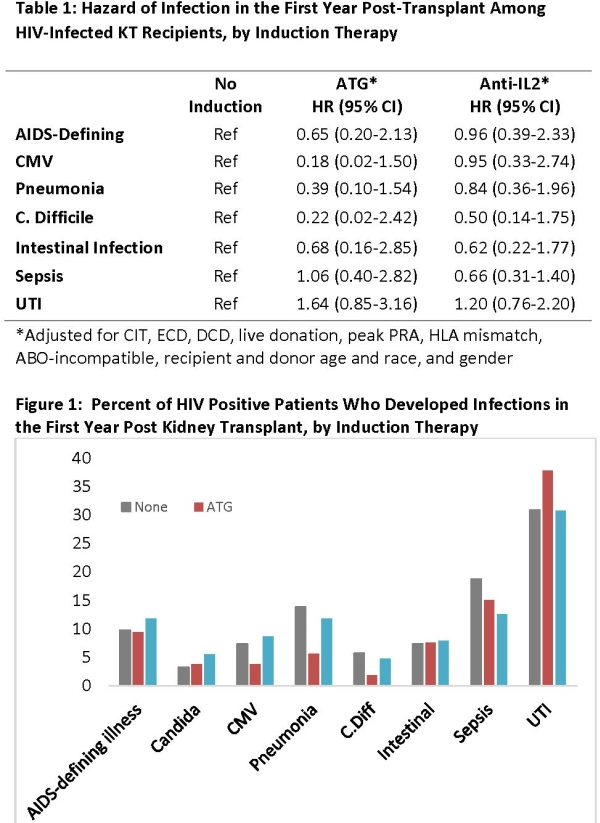Induction With ATG Is Not Associated With Increased Infections After Kidney Transplant Among HIV Positive Patients: Results of a National Study
1JHU, Baltimore
2UAB, Birmingham.
Meeting: 2015 American Transplant Congress
Abstract number: 154
Keywords: HIV virus, Immunosuppression
Session Information
Session Time: 8:30am-9:30am
 Presentation Time: 8:45am-9:00am
Presentation Time: 8:45am-9:00am
Location: Terrace Ballroom 1, 2, 3
Anti-thymocyte globulin (ATG) is widely used for induction, particularly for those at high risk for rejection. HIV+ kidney transplant (KT) recipients have 3 fold higher rejection rates and thus may benefit from ATG. However, in one study of HIV+ patients ATG was associated with an increased risk of infection. This single study with a small sample size has caused reluctance to use ATG for HIV+ recipients, and in some cases reluctance to transplant HIV+ patients at all. We used national registry data to analyze associations between ATG and post-transplant infections in a larger cohort.
Methods: We studied 89,040 HIV- and 315 HIV+ first time KT recipients from 1999-2010 with Medicare primary insurance as captured in SRTR. Infections in the first year post-KT were ascertained via ICD-9 codes. Cox proportional hazards models were built to assess the hazard of each infection for HIV (+) patients who received 1) ATG, and 2) anti-IL-2, compared to those who received no induction.
Results: Compared to HIV- patients, HIV+ were less likely to receive ATG induction (16.8% vs 31.9%), and more likely to anti-IL-2 (40.6% vs 31.6%) or no induction (39.1% vs 30.0%). HIV+ patients who received ATG had a higher peak PRA (28.8 vs 20.3 with anti-IL2 and 11.3 for no induction); other characteristics were similar. Compared to no induction, neither ATG nor anti-IL2 was associated with an increased hazard of AIDS-defining infections, sepsis, CMV, pneumonia, C. difficile, UTI, candida, or intestinal infections among HIV+ patients in models adjusted for potential confounders (Table 1). ATG induction recipients had a lower risk of CMV (3.8% vs 8.7% with anti-IL-2 and 7.9% with no induction), pneumonia (5.7% vs 11.8% with anti-IL-2 and 13.8% with no induction), and C. difficile (1.9% vs 4.7% with anti-IL-2 and 5.7% with no induction, Figure 1).
Conclusions: In the largest study to date, ATG does not appear to increase the risk of post-KT infection for HIV+ patients; ATG use should not be absolutely contraindicted in this population and fear of infection should not be a barrier to transplantation of appropriate HIV+ candidates.

To cite this abstract in AMA style:
Kucirka L, Durand C, Bae S, Locke J, Segev D. Induction With ATG Is Not Associated With Increased Infections After Kidney Transplant Among HIV Positive Patients: Results of a National Study [abstract]. Am J Transplant. 2015; 15 (suppl 3). https://atcmeetingabstracts.com/abstract/induction-with-atg-is-not-associated-with-increased-infections-after-kidney-transplant-among-hiv-positive-patients-results-of-a-national-study/. Accessed December 29, 2025.« Back to 2015 American Transplant Congress
